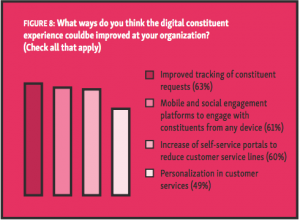This blog post is an excerpt from GovLoop’s recent Research brief, “How Digital Services Can Optimize the Constituent Experience.”
Government faces a number of customer service challenges. Agencies at the state and local levels continue to struggle with underfunding and staffing reductions. At the same time, citizens are demanding new ways to connect and transact with government. They want a streamlined experience, transparency and better quality of service to match the consumer experience they get when searching, shopping and communicating online. Agencies need better solutions to serve an increasingly tech-reliant public as well as an easier and more efficient way to work internally.
That’s why digital services, fueled by new technologies and cloud computing, can transform the way government engages constituents and provides programs. Such services can help a citizen do everything from transfer a car title to obtain a business permit or license. By delivering services through digital channels, state and local governments can improve the overall customer process and experience, both for the agency employee and the constituent.
To understand how digital services can help state and local agencies optimize the constituent experience, GovLoop partnered with Infor, a leading software provider with solutions dedicated to improving constituent engagement through digital services, to survey state and local government employees. Over 70 percent of the respondents interact frequently or at least once a week with constituents as part of their job.
The survey aimed to understand government employees’ views about digital services and their impact on constituent services. Bob Benstead, Vice President of Business Development, Public Sector at Infor helped highlight the important findings of the survey.
Solutions to Improve Digital Services
Because there are so many ways to improve digital services at the state and local levels, many agencies often don’t know where to start. That’s why, when evaluating customer services, it can help to assess how digital services can improve the experience both for the employee and the constituent.
Digital services should be able to give employees holistic visibility over requests, so staff members provide one consistent answer. Equally important is being able to meet constituents where they are, whether through user-friendly self-service portals or through delivering services right to their mobile devices and preferred social media channels.
When asked, “What ways do you think the digital constituent experience could be improved at your organization?” the top responses were “improved tracking of constituent requests,” “mobile and social engagement platforms to engage with constituents from any device” and “increasing self-service portals to reduce customer service lines” (Figure 8).

In order for agencies to improve in these three key areas, Benstead suggested:
1. Improved tracking: Get customer feedback across the board to understand exactly what they want to address. Once you have compiled feedback, improve the tracking of requests with automation to better process and keep track of constituent interactions and requests with an agency.
2. Mobile and social engagement platforms: Use metrics to establish the platforms your agency should use. For example, if your agency offers permits, you may set a goal of moving 20 percent of permit services online or to shorten processing time for permits to two weeks instead of six. Then decide which platforms to use to meet those goals.
3. Self-service portals: Have a “lead me capability.” This means your agency’s website can direct constituents to the service they need through a series of questions. Constituents never have to call or drive to the agency to find what they’re looking for. This, in effect, allows the breakdown of government silos and barriers.
Better digital services can improve customer service by increasing government productivity and efficiencies with more online self-services and targeted, relevant content. State and local governments stand to gain a number of benefits with improved digital services. Citizens can get easier access to government information and services that they can engage anywhere, from any device. With online engagement platforms, digital services can enhance the relationship between government and constituents with 24/7, easy-to-access services and better communication methods. Equally important, if implemented correctly, digital services can greatly increase government’s transparency and accountability to the public.






Leave a Reply
You must be logged in to post a comment.